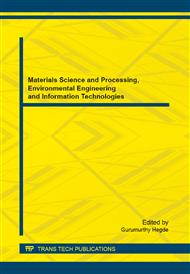[1]
Liu Hui, Gu Hongbin, Chen Dawei, Application of High-speed Solenoid Valve to the Semi-active Control of Landing Gear[J], Chinese Journal of Aeronautics 21 (2008) 232-240.
DOI: 10.1016/s1000-9361(08)60030-8
Google Scholar
[2]
Aircraft design manual editorial committee. Aircraft design manual, 14th books: take-off landing system design [M]. Beijing: aviation industry press, 2002. 12.
Google Scholar
[3]
Zhu Shuhua, Tong Mingbo, Xu Jie, Design of sign of new passive adaptive shock absorber of landing gear and study of its landing performance[J]. Transactions of Nanjing University of Aeronautics &Astronautics. Mar. 2009 . Vol. 26, No. 1.
DOI: 10.1109/asc-icsc.2008.4675338
Google Scholar
[4]
G. Mikulowski, J. Holnichi-szulc. Adaptive aircraft shock absorbers. AMAS Workshop on Smart Materials and Structures, Jadwisin, September 2-5, 2003 (p.63–72).
Google Scholar
[5]
He jie, Gao lixia, Long zheng, Liu yongzhi, Liu xiumei, Theoretic and experimental study of chain-formation mechanism for MRF[J]. Jounal of functional materials, January, 2013, Vol. 44, No. 2.
Google Scholar
[6]
Zhou yun, Tan ping. Magnetorheological damping control theory and technology [M], Beijing: Science press, Mar, (2007).
Google Scholar
[7]
Batterbee D C, Sims N D, Stanway R. Magnetorheological Landing Gear: 2. Validation Using Experimental Data[J]. Smart Materials and Structures, 2007, 16(6): 2441-2452.
DOI: 10.1088/0964-1726/16/6/047
Google Scholar
[8]
Batterbee D C, Sims N D, Stanway R. Magnetorheological Landing Gear: 1. A Design Methodology[J]. Smart Mate rials and Structures, 2007, 16 (6): 2429-2440.
DOI: 10.1088/0964-1726/16/6/046
Google Scholar
[9]
Jia Yuhong, Wu Xiaojuan, Fuzzy control of landing gear based on M R damper [J]. Journal of Beijing University of Aeronautics and Astronautics, 2007, 2007, 33 (11 ): 1264-1267.
Google Scholar
[10]
LIU Hui, GU Hongbin, WU Dongsu, Shock absorber performance study of semi-active control of landing gear[J]. Acta aeronautica et astronautica sinica, Sept. 2006, Vol. 27, No. 5.
Google Scholar
[11]
Wang Wei, Xia Pinqi, Adaptive Control of Helicopter Ground Resonance with Magnetorheological Damper[J]. Chinese Journal of Aeronautics 20(2007) 501-510.
DOI: 10.1016/s1000-9361(07)60074-0
Google Scholar
[12]
TIAN Jing, DING Li, KONG Ling-shuai, ZHU Shi-xing, Simulation and Analysis of Semi-Active Control for MR Damper Landing Gear[J]. Chinese Hydraulics & Pneumatics, 2012, No. 1.
Google Scholar
[13]
Choi Y T, Wereley N M. Vibration Control of a Landing Gear System Featuring Electrorheological /Magnetorheological Fluids[J]. Journal of Aircraft, 2003, 40(3): 432-439.
DOI: 10.2514/2.3138
Google Scholar
[14]
Disha Saxena, Harsh Rathore. Vibration Control of MR Damper Landing Gear[C]. International Journal of Advanced Research in Artificial Intelligence, 2013, 2(3): 72-76.
DOI: 10.14569/ijarai.2013.020311
Google Scholar
[15]
Bai Yu. Study of landing gear damper optimal control on the principle of MR[D]. Tinjin: Civil Aviation University of China, (2009).
Google Scholar


